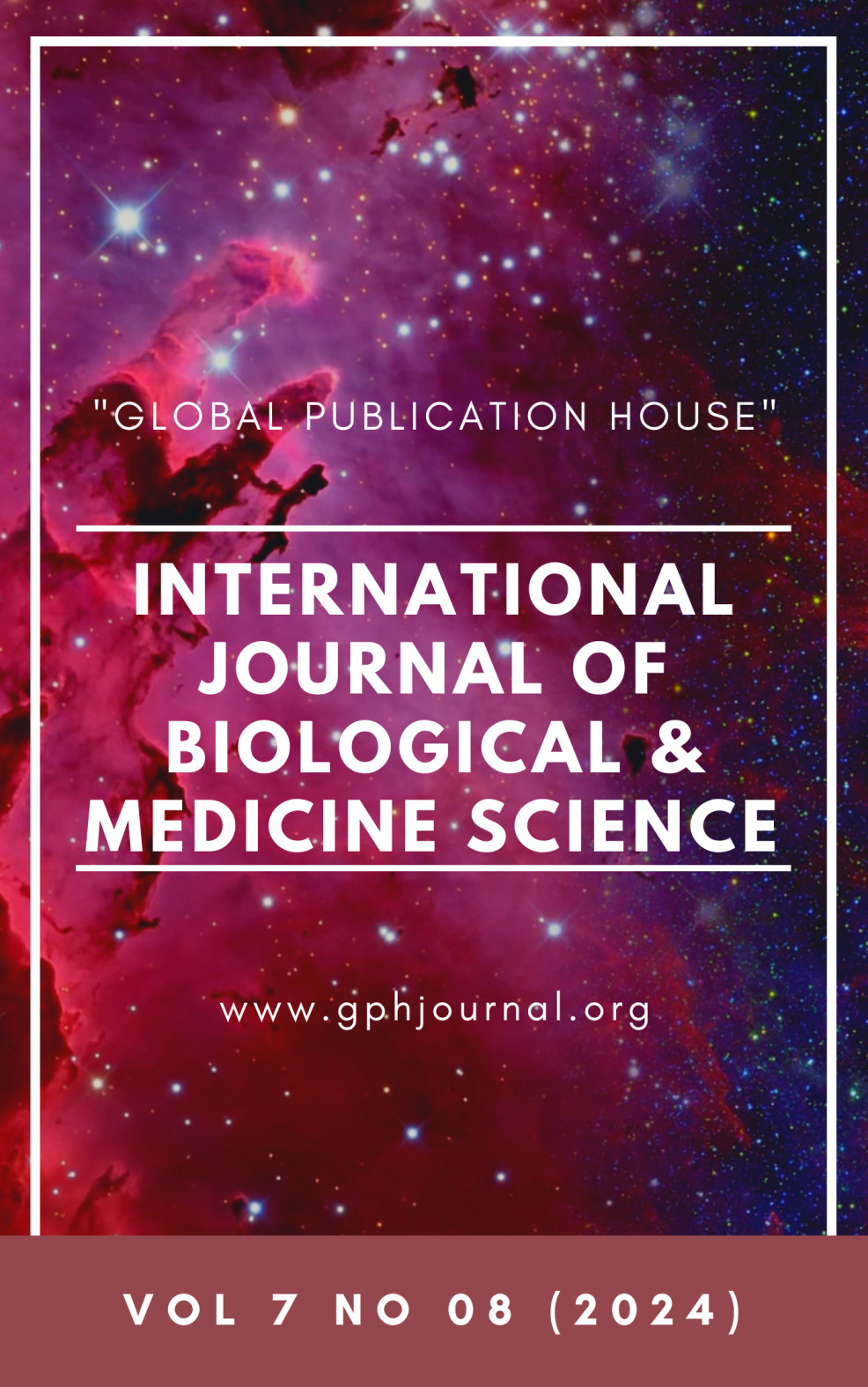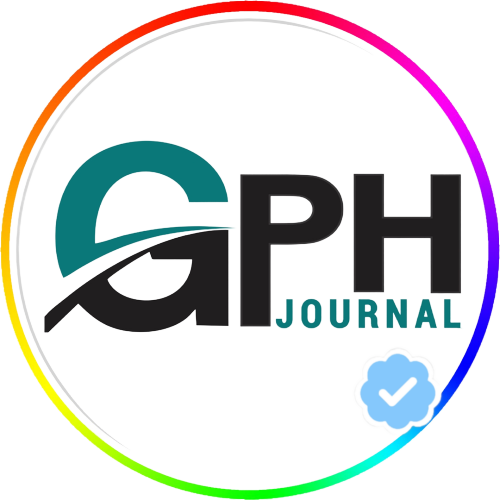Changes in Biochemical Indices in Lead-Induced Toxicity Following Administration of Methanolic Extracts of Curcuma longa Rhizomes and Cucumis sativus Fruits
Abstract
Biochemical indices are important biomarkers of health and disease state in both humans and rodents. This study was designed to evaluate plausible changes in biochemical indices in lead-induced toxicity following administration of methanolic extracts of Curcuma longa rhizomes and Cucumis sativus fruits. Twenty five (25) male rats weighing between 145g-200g were purchased, acclimatized and subsequently randomly distributed into five (5) groups(5 rats each) and were treated for 28 daysas follows: Group 1: Control group (received distilled water and normal feed only); Group 2: received a daily dose of 2.25mg/kg lead for 28 days; Group 3: rats received 2.25mg/kg lead + 200mg/kg Curcuma longa rhizome extract; Group 4: rats received 2.25mg/kg lead + 500mg/kg Cucumis sativus extract; Group 5: rats received 2.25mg/kg lead + 200mg/kg Curcuma longa rhizome + 500mg/kg body weight of Cucumis sativus extracts. Daily treatments with lead and extracts were orally. Testes were harvested and homogenized for determination of testicular cholesterol and nitric oxide levels on day 29, also blood was collected via direct cardiac puncture for serum liver enzymes and lipid parameters estimation. Expectedly, significantly higher values of testicular cholesterol, aspartate aminotransferase, alanine aminotransferase, alkaline phosphatase, total cholesterol, triglyceride and low-density lipoprotein but decrease nitric oxide, total protein, albumin and high-density lipoprotein levels were observed amongst group 2 rats administered 2.25mg/kg lead compared to group 1 ratsp<0.05, suggesting a possible deleterious effect of lead. Predictably, individual doses of the extracts of Curcuma longa rhizome and Cucumis sativus administration to groups 3 and 4 rats significantly ameliorated the above parametersp<0.05, suggesting a likely beneficial effect of Curcuma longa and Cucumis sativus extracts with Curcuma longa rhizome showing greater potency compared to Cucumis sativus. Combined administration of both extracts to group 5 rats showed better therapeutic efficacy compared to both groups 3 and 4 rats. Results suggests that combined treatment with Curcuma longa and Cucumis sativus may present better outcome compared to individual administration. More studies are recommended to this end.
Downloads
References
2. Balali-Mood, M., Naseri, K., Tahergorabi, Z., Khazdair, M. R., & Sadeghi, M. (2021). Toxic Mechanisms of Five Heavy Metals: Mercury, Lead, Chromium, Cadmium, and Arsenic. Frontiers Pharm. 2021: (5)12, 643972. https://doi.org/10.3389/fphar.2021.643972.
3. Benjamin, M.N. Outline of Veterinary Clinical Pathology, University Press, Iowa, USA. Pp. 1978: 229-232.
4. Chawla, R. Practical clinical biochemistry (Methods and Interpretation). 3rd Edn. New Delhi, India: Jaypee Brothers. 2003.
5. Davem, T.L. and Scharschmidt, B.F. Biochemical Liver Function Tests. In: Feldman, M., L.C. Friedman and M.H. Sleisenger (eds) Sleisenger and Fordtrans’ Gastrointestinal and Liver Disease Pathophysiology, Diagnosis and Management. Elsevier Science, California. 2002.
6. Ezebuiro Ijeoma, Chibuike Obiandu, Friday Saronee, Ikechukwu I. Weleh and Adesua C. Obiandu. Effects of Cnidoscolus aconitifolius on Some Hematological Parameters of Male Wistar Rats. Asian J Biotech Biores Tech. 2020: 6(3): 1-5
7. Fortune S. Amah-Tariah, Joy O. A. Laz-Okenwa and Mpakaboari T. Bekinbo. Changes in Nitric Oxide Levels in Lead-Exposed Male Rats Co-Treated with Methanolic Extracts of Curcuma longa Rhizomes and Spondias mombin Leaves. Inter J Res Scientific Inno. 2019: 6(8); 128-131.
8. Gopinathan, NM; Sai Harish Singh, Chitra, K; Uma Maheswara Reddy, C. In-vitro antiplatelet activity- ethanolic extract of rhizome of Curcuma longa Linn. Int J Biomed Res. 2011: 2 (2):138-142.
9. Hamid, A. A., Aiyelaagbe, O. O., Usman, L. A., Ameen, O. M., & Lawal, A. Antioxidants: Their role in health and disease. J Med Plants Res. 2010: 4(9), 747-757.
10. Ijeoma Ezebuiro, Chibuike Obiandu, Friday Saronee and Adesua C. Obiandu. Effects of Leaf Extract of Cnidoscolus aconitifolius on Serum Lipids and Oxidative Stress Markers of Male Wistar Rats. Asian J Biochem Genetics Molecular Bio. 2020: 5(1): 47-52. DOI: 10.9734/AJBGMB/2020/v5i130120.
11. Ikechukwu I. Weleh and Friday Saronee. Effects of Hydromethanolic Extract of Cnidoscolus Aconitifolius (Buphorbiacaea) on Body Weight, Some Liver Enzymes and Histology in Diabetic Wistar Rats. International Journal of Research and Scientific Innovation. 2019: 6(9); 190-194.
12. Kurian, A. W., Axilbund, J. E., Buys, S. S., Crawford, B., Farrell, C. D., Friedman, S., … & Garber, J. E. Genetic/familial high-risk assessment: breast and ovarian. J National Comp. Cancer Network, 2010: 8(5), 562-594.
13. McLean, S., Sheikh, A., Cresswell, K., Nurmatov, U., Mukherjee, M., Hemmi, A., & Pagliari, C. The impact of telehealthcare on the quality and safety of care: A systematic overview. PLOS ONE, 2013: 8(8), e71238. https://doi.org/10.1371/journal.pone.0071238
14. Okwu DE. Evaluation of the chemical composition of indigenous spices and flavoring agents. Global J Pure Appl Sci. 2001: 7 (3):455-459.
15. Ruiz-Navajas, Y., Viuda-Martos, M., Fernández-López, J., & Pérez-Alvarez, J.A. Functional properties of honey, propolis, and royal jelly. J Food Sci. 2011: 76(9), R117-R124. https://doi.org/10.1111/j.1750-3841.2011.02494.x
16. Saronee F, Amah-Tariah FS, Chinko BC and Dapper DV. GC-MS and proximate analysis of the hydromethanol extract of Craterispermum schweinfurthi leaves. South Asian Res. J. Nat. Prod. 2023; 6(2):101-109.
17. Saronee F; Bekinbo MT; Ojeka SO; Dapper, DV. Comparative Assessment of Methanolic Extracts of Hog Plum (Spondias mombin linn.) Leaves and Turmeric (Curcuma longa L.) Rhizomes on Blood Glucose and Glycosylated Hemoglobin in Male Wistar Rats. J. Appl. Sci. Environ. Manage. 2019: 23 (9) 1631-1636. DOI: https://dx.doi.org/10.4314/jasem.v23i9.4
18. Saronee, F., Amah-Tariah, F. S., Chinko, B. C., & Dapper, D. V. Ameliorative effects of the hydromethanol leaf extract of Craterispermum schweinfurthii on phenyl hydrazine induced anemia in male Wistar rats. International Journal of Recent Research in Life Sciences, 2023: 10(3), 19-25. DOI: https://doi.org/10.5281/zenodo.8176890.
19. Saronee, F., Dan-jumbo, D., & Azosibe, P. Aphrodisiac properties of Craterispemum schweinfurthi Leaf Extract in Lead Induced Testicular Toxicity in Male Wistar Rats. Journal of Applied Science and Environmental Management, 2024: 28(5), 1513-1518. DOI: https://dx.doi.org/10.4314/jasem.v28i5.23.
20. Saronee, F., Sunday, O. O., Okekem, A., Ogadinma, N. I., & Datonye, V. D. Comparative Study of the Effects of Methanolic Extracts of Spondias mombin Leaves and Curcuma longa Rhizomes on Serum Lipid Profile and Electrolytes in Alloxan Induced Diabetes in Male Wistar Rats. Asian J Advanced Res Reports, 2020: 8(3), 1 9. DOI: 10.9734/AJARR/2020/v8i330198.
21. Sawant, RS; Godghate, AG. Qualitative phytochemical screening of rhizomes of Curcuma longa Linn. Int J Environ Sci Technol, 2013: 2(4):634 641.
22. Singh, V.P., Singh, S., Kumar, J. and Prasad, S.M (2015). Hydrogen sulfide alleviates toxic effects of arsenate in pea seedlings through up-regulation of the ascorbate-glutathione cycle: Possible involvement of nitric oxide. J Plant Physio. 18:20-9.
23. Stein, E. A. Textbook of clinical chemistry. Philadelphia: W.B. Saunders Co.1986.
24. US. NRC. Committee for the Update of the Guide for the Care and Use of Laboratory Animals 2019. Available from: https://www.ncbi.nlm.nih.gov/books/NBK54050/ downloaded on the 20th of June, 2022. 2019.
25. Vivek, K. B., Ji-Eun, K., Yong-Ha, P., & Sun, C. K. In-vivo pharmacological effectiveness of heat-treated cucumber (Cucumis sativus L.) juice against CCl4-induced detoxification in a rat model. Indian J Pharmaceu Edu Res. 2016: 51(2), 280-287.
26. Wallach, J.B. Interpretation of diagnostic tests. Lippincott Williams & Wilkins. 2007: 23(5):67-89.
27. Yuandani, ES Acute toxicity evaluation of ethanol extract of Curcuma mangga rhizome. Asian J. Pharm. Clin. Res. 2017:10 (1):383-385.
Author(s) and co-author(s) jointly and severally represent and warrant that the Article is original with the author(s) and does not infringe any copyright or violate any other right of any third parties, and that the Article has not been published elsewhere. Author(s) agree to the terms that the GPH Journal will have the full right to remove the published article on any misconduct found in the published article.























